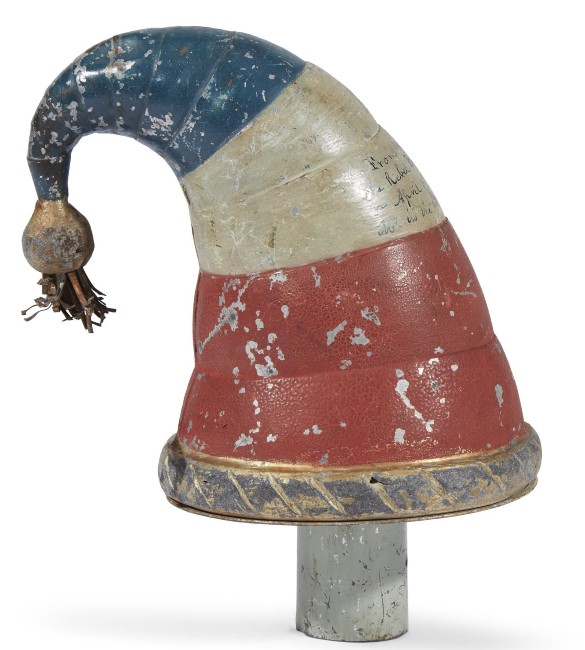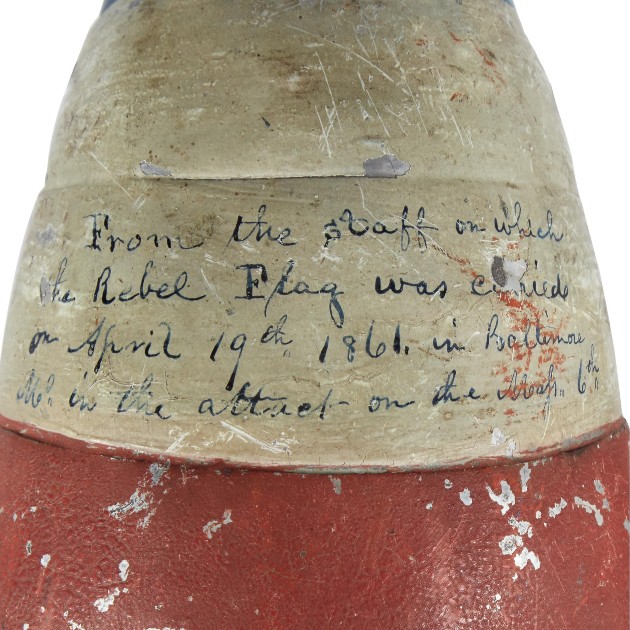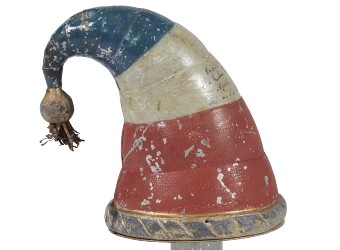
What you see: A painted tinware and zinc Liberty cap flag finial that was part of one of the earliest deadly incidents of the Civil War—the Pratt Street Riot of April 1861. Freeman’s estimates it at $15,000 to $25,000.
The Expert: Lynda Cain, vice president and department head for American furniture, folk and decorative arts at Freeman’s.
How often do you see an antique flag finial that’s worth anything on its own? Are other flag finials of the period as visually interesting as this one? It clearly looks like a parade finial, meant for parades and political things. Figural pieces like this are very rare. This is the only example I’ve seen like this. I don’t know that anyone has seen one like this.
How would this Liberty cap flag finial have been used? It’s meant to be raised on the top of a flagpole. With this one, it has a history of being raised and used. The only others I’ve seen like this have been political lanterns [used in torchlight parades].
Would this have been a common, easily obtainable decorative piece in the mid-19th century? Or was it closer to handmade? I don’t know. In the mid-19th century, there were all sorts of companies making political and military material. It was popular, especially lanterns, and especially at midcentury. At the same time, many [metal] weathervanes were made. The finial is tin and zinc. It’s rather sophisticated.
So, a company that made weathervanes might also have made something like this Liberty cap flag finial? It could have. A very talented tinsmith made it.
So it’s not homebrew. No, no.
Could you talk a bit about the Liberty cap form, and the symbolic significance of the Liberty cap? It traces its origins to antiquity. It was originally from Anatolia, in Turkey. People who the Romans considered barbarians wore this kind of cap. They were a free-spirited people. Later, freed slaves in Rome wore the cap to indicate they were free citizens. You even see it in Roman statuary. But we most closely associate it with the French Revolution. Today, it’s used on many state crests, and on the panoply of arms of the U.S. Army. It’s become one with liberty.
Is the Liberty cap flag finial solid? It’s hollow.
What do I see dangling from the end of the Liberty cap flag finial? It looks like a tassel, but it’s gilded heavy wire.
What might the tassel material have looked like when the Liberty cap flag finial was new? I think it probably looked a bit more like a tassel, and the paint would have been brighter and fresher.
The tassel-like stuff at the back wouldn’t have been longer? Maybe it was a bit longer, but the gilt is pretty much there.
This Liberty cap flag finial was carried by someone at what became known as the Pratt Street Riot, in 1861. What was the Pratt Street Riot? It was in the very early days of the Civil War, five days after Fort Sumter was surrendered. A Massachusetts regiment was headed to Washington, D.C., to defend the capital. They had to change trains in Baltimore, and they had to move from one train to another. A crowd gathered that was unhappy.
And the crowd would have been supporters of the South? They were definitely on the side of the South, this group of people. They followed the soldiers to the trains, and there was kind of a stand-off. Supposedly in this group, the finial was on the flagpole, flying a Southern flag, but it wasn’t really an official Southern flag at that moment. Shots were fired, and people were killed, along with innocent bystanders. They were the first casualties of the Civil War. Someone has inscribed the finial on the front: “From the staff of which the Rebel Flag was carried on April 19th 1861 in Baltimore Md. in the attack on the Mass 6th.” [Eleven civilians and five soldiers died in the incident.]
I see a lot of nicks and dings on the painted surface of the Liberty cap flag finial. Is that the wear you would expect from a metal piece of this vintage, or do these nicks and dings represent damage it may have received during the Pratt Street Riot? We don’t know any of those things. We don’t know anything about when it was carried at the Pratt Street Riot. The consigner, who is a Pennsylvanian on the Main Line, purchased it from a couple, and it did descend in their family. He probably purchased it about 15 years ago.
So there’s no way to be sure that the paint loss we see on the Liberty cap flag finial was caused by being knocked around at the Pratt Street Riot? We don’t know. We can’t really call it ephemera, but I don’t think it was put on a pedestal. It could have been beat up. It could have been in other parades. We don’t know.
People didn’t have much of a collecting mentality in 1861. Why might someone have kept this Liberty cap flag finial and recorded its role in the Pratt Street Riot directly on it? You’ve got to remember, there were early collectors, who had the idea that the [American] centennial was not too far away. There were people who hung on to things, and they did save things from the Civil War. Things were retained and treasured.
Depending on when the inscription was written, couldn’t it have been evidence of the Liberty cap flag finial having been present at the scene of a violent crime? We don’t know when the inscription was put on. It could have been the late 19th century. It’s not uncommon to have it done later or at the time. So many times, we see notes on things, pinned to an object because they wanted to keep the history with the piece.

So we don’t have any idea who inked the inscription on the Liberty cap flag finial, or when they might have done it? I can’t tell, but it looks like 19th-century handwriting to me.
Do we have any notion of why the person who inscribed it wrote directly on the white part of the Liberty cap flag finial? I suppose they put it there because it’s the largest flat surface. At the back, it’s sort of ridged. And I think it shows on the white part. They could have put the inscription on the underside, but I don’t think they thought about where they were making it. They really wanted to make the point that it was an important piece, [that it was] at the Pratt Street Riot. That meant more to the person who marked it than anything else. They wanted to make it permanent.
What is the Liberty cap flag finial like in person? It’s very cool, just a fabulous object. It looks sculptural, really amazing. I’ve just never seen anything like this.
What’s it like to handle this piece? It’s kind of chubby on the bottom, and it tapers. It’s got a nice feel to it, a nice weight.
Is that pole-like whitish thing sticking out from the bottom of the Liberty cap flag finial part of the piece, or is it just something you placed it on to photograph it? It’s all attached. The extension is part of it. There’s a conical section that’s been hollowed out [at the bottom of the extension]. The pole goes into that.
What comparables did you look to when writing the estimate for the Liberty cap flag finial? I didn’t find any. It may be unique. It’s got a great presence. It’s a very rare object. Is it a folk art object? Almost. It’s political history, it’s military history. It’s an extreme rarity. And it’s a Liberty cap, a symbol of liberty since ancient times–an inescapable association. It’s significant as a piece of Americana. $15,000 to $25,000 is not crazy.
Why will this piece stick in your memory? I’ve never seen one like it. [Laughs.] I find it highly satisfying. As a hat form, I think it’s a fabulous object. It really does look like a Liberty cap. Whoever created this did a magnificent job of creating the appearance of a soft cap out of tin. You can see the lines where it folds over, as if it’s a soft material. I think it’s remarkable. I’m hoping another will come out of the woodwork. It’s always good to find another one, I think.
How to bid: The Liberty cap flag finial is lot 95 in the American Furniture, Folk & Decorative Arts sale taking place at Freeman’s on April 28.
___
By SHEILA GIBSON STOODLEY
Sheila Gibson Stoodley is a journalist and the author of The Hot Bid, which features intriguing lots coming up at auction.
[av_button label=’To Auction Preview’ link=’manually,https://www.liveauctioneers.com/news/auctions/upcoming-auctions/freemans-auction-april-28-features-chippendale-tall-clock/’ link_target=’_blank’ size=’large’ position=’center’ label_display=” title_attr=” icon_select=’no’ icon=’ue800′ font=’entypo-fontello’ color=’theme-color’ custom_bg=’#444444′ custom_font=’#ffffff’ av_uid=’av-6xyjzsz’ id=” custom_class=” admin_preview_bg=”]


